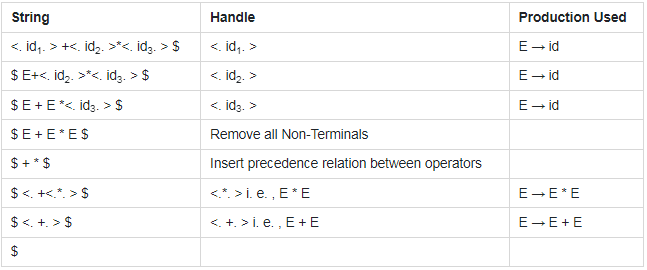Handles | Compiler Design - Computer Science Engineering (CSE) PDF Download
Introduction
A handle is a substring that connects a right-hand side of the production rule in the grammar and whose reduction to the non-terminal on the left-hand side of that grammar rule is a step along with the reverse of a rightmost derivation.
Finding Handling at Each Step
Handles can be found by the following process −
- It can scan the input string from left to right until first .> is encountered.
- It can scan backward until <. is encountered.
- The handle is a string between <. and .>
Example 1: Consider the Grammar
E → E + E|E * E|(E)id.
Find handles at each step for reducing the string id1 + id2 * id3 using operator Precedence Parsing.
First, Attach $ at starting and ending of string i.e., $id1 + id2 * id3 $.
Put Precedence relation between operators & symbols using Precedence Relation Table.
∴ $ <. id1. > +<. id2 >*<. id3 > $
Apply 3 steps as explained above on the string.
Example 2: Compute FIRST & LAST terminals of non-terminals E, T, and F in the following Grammar.
E → E + T| T
T → T * F | F
F → (E)| id
On seeing the production, we can judge
+ is the first terminal of E
* is the first terminal of T
(, id is the first terminals of F.
But E → T → F
∴ The First Terminal of F is contained in the First terminal of T and the First Terminal of T is contained in the First Terminal of E.
∴ First(F) = {(, id}
∴ First(T) =*∪ First (F) = {*, (, id}
First(E) = + ∪ First (T) = {+,*, (, id}
Similarly, the Last Terminals can be found.
Example 3: Consider the Grammar
E → E + T|T
T → T ∗ F|F
F → (E)| id
Perform Stack Implementation for string id + id * id using operator precedence parsing.
Precedence rules <. , .> or =. holds between the top of the stack and the current input symbol. If the top of the stack is Non-terminal, then the terminal below the top of the stack will be compared with the current input symbol.
|
26 videos|90 docs|30 tests
|
FAQs on Handles - Compiler Design - Computer Science Engineering (CSE)
| 1. What is Computer Science Engineering (CSE)? |  |
| 2. What are the career prospects for Computer Science Engineering graduates? |  |
| 3. What are some popular programming languages that Computer Science Engineering students should learn? |  |
| 4. What skills are important for success in Computer Science Engineering? |  |
| 5. How can I prepare for the Computer Science Engineering (CSE) exam effectively? |  |



















